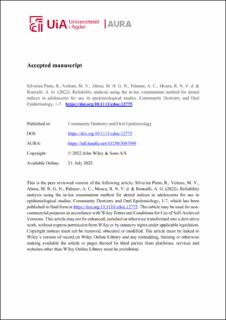Reliability analysis using the in-lux examination method for dental indices in adolescents for use in epidemiological studies
Silverira Pinto, Rafaela; Vettore, Mario Vianna; Abreu, Mauro Henrique Guimarães Nogue; Palmier, Andrea Clemente; Moura, Rosa Núbia Vieira de; Roncalli, Angelo Giuseppe
Journal article, Peer reviewed
Accepted version
Permanent lenke
https://hdl.handle.net/11250/3047999Utgivelsesdato
2022Metadata
Vis full innførselSamlinger
Originalversjon
Silverira Pinto, R., Vettore, M. V., Abreu, M. H. G. N., Palmier, A. C., Moura, R. N. V. d. & Roncalli, A. G. (2022). Reliability analysis using the in-lux examination method for dental indices in adolescents for use in epidemiological studies. Community Dentistry and Oral Epidemiology, 1-7. https://doi.org/10.1111/cdoe.12775Sammendrag
Objective: To evaluate the in- lux examination method to assess the reliability of exam-iners for oral health surveys.
Methods: A calibration study involving 10 examiners and 27 patients was conducted, and high-quality photographs of dental epidemiological indices were projected. The latter refers to the in- lux examination method. Two groups, comprised of five ex-aminers each, were trained to assess dental caries (DMFT index) and malocclusion (DAI). The first group carried out in vivo (clinical) and in- lux examinations in the same patients. The second group performed in- lux examinations only. The measurements were repeated to obtain intraexaminer weighted kappa coefficients.
Results: Interexaminer weighted kappa coefficients of the in vivo examination method for DMFT and DAI ranged from 0.597 to 0.851 and from 0.574 to 0.844, respectively. The values for in- lux examination were between 0.440 and 0.856 (DMFT) and be-tween 0.524 and 0.783 (DAI). The intraexaminer kappa coefficients of the in vivo examination method ranged between 0.569 and 0.851 (DMFT) and between 0.644 and 0.834 (DAI). In the in- lux method, these values were between 0.426 and 0.831 (DMFT) and between 0.341 and 0.838 (DAI). Three examiners did not reach the mini-mum acceptable kappa value (k= 0.610) for DMFT, and one for DAI. Of these, one examiner managed to reach the minimum kappa coefficient for DMFT after additional training. The three others maintained the kappa coefficients at lower than acceptable limits.
Conclusions: Calibration, using both in vivo and in- lux examination methods, was able to discriminate the examiners regarding their reliability to reproduce dental indices. The in- lux examination method was considered reliable and can replace the in vivo ex-amination method. The in- lux method might be more feasible to evaluate the reliability of examiners when clinical calibration is unrealistic due to logistic issues and when a large number of examiners are involved in the survey.
